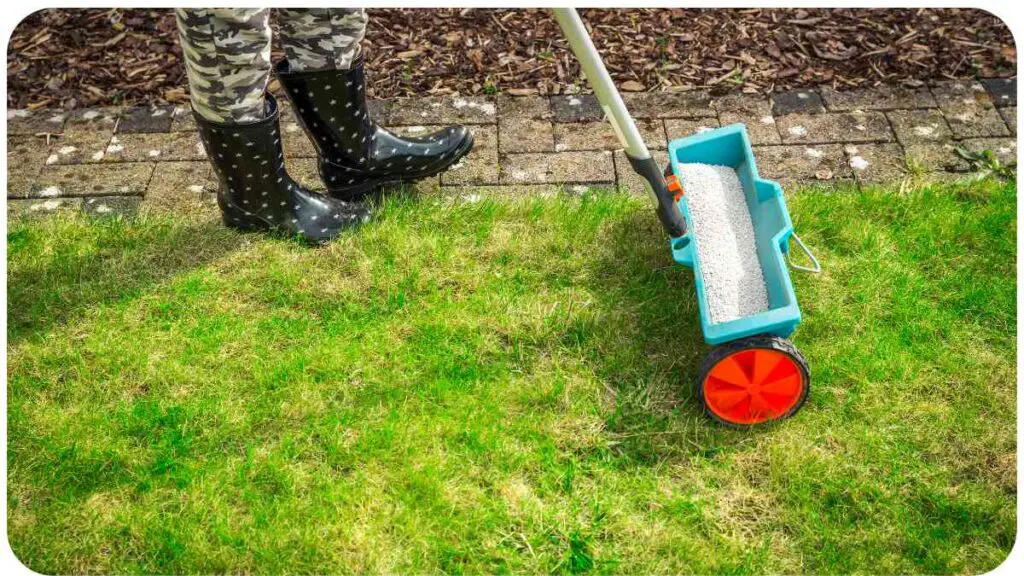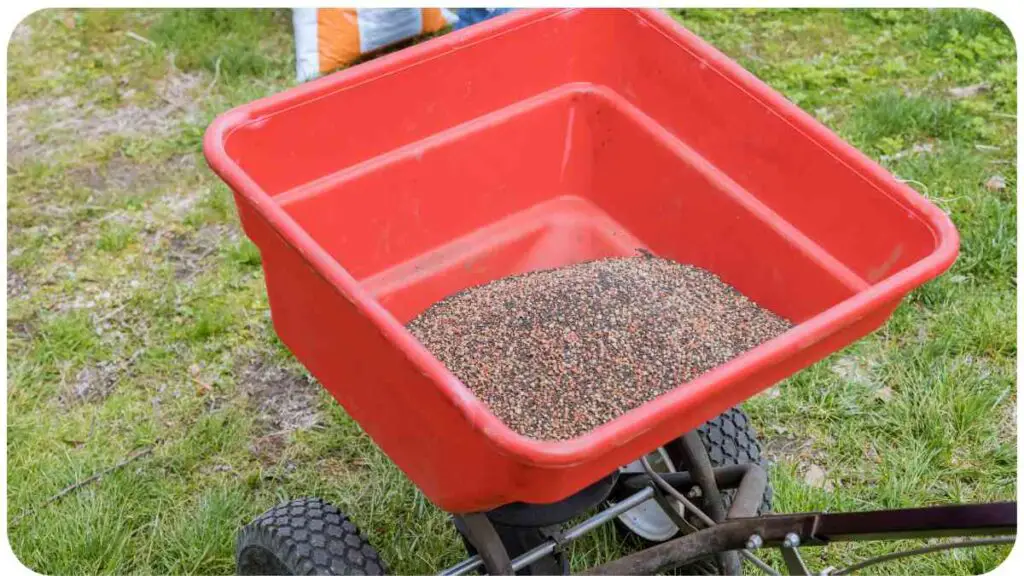Maintaining a lush, vibrant lawn requires more than just watering and mowing. Proper fertilization plays a pivotal role in nurturing your grass to its full potential. The Scotts Lawn Spreader has emerged as a trusted companion for countless lawn enthusiasts, promising even fertilizer distribution and a healthier lawn.
However, like any piece of equipment, challenges can arise. In this comprehensive guide, we’ll delve into troubleshooting the Scotts Lawn Spreader, offering setup tips and tricks derived from years of expertise and practical experience.
| Takeaway |
|---|
| Proper assembly is the foundation for effective spreader use. |
| Calibrating your spreader accurately ensures even fertilizer distribution. |
| Regular maintenance and cleaning prevent spreader jams and extend its lifespan. |
| Understanding your lawn’s needs and adjusting settings accordingly is essential. |
| Different seasons demand specific fertilizer types and application methods. |
| Storing your spreader correctly prolongs its life and maintains performance. |
| Expert insights provide valuable tips and tricks for successful spreading. |
| Troubleshooting challenges becomes manageable with the right knowledge. |
| Your well-maintained spreader leads to a lush, vibrant lawn that’s the envy of your neighbors. |
Understanding the Scotts Lawn Spreader
Before we dive into troubleshooting, let’s take a moment to understand the Scotts Lawn Spreader and its significance. This innovative device simplifies the task of evenly distributing fertilizer across your lawn.
It operates based on a hopper mechanism, where you fill the hopper with your chosen fertilizer, and as you walk, the spreader releases the fertilizer, covering a designated area with a uniform layer. This process ensures consistent growth and minimizes the risk of over-fertilization.
When planning your outdoor space, consider factors such as costs, designs, and materials. How Much Does It Cost to Fully Landscape a Backyard? This article breaks down the expenses and options, helping you make informed decisions.
Common Issues You Might Encounter

Uneven Fertilizer Distribution
A lush, uniform lawn starts with an even spread of fertilizer. One common issue is uneven distribution, which can result from various factors such as uneven terrain, incorrect spreader settings, or even walking too quickly.
To address this, refer to the spreader’s user manual to understand the recommended settings for your chosen fertilizer type and adjust your walking speed accordingly.
Difficulty in Calibration
Calibrating your spreader accurately is key to achieving the desired fertilizer coverage. Improper calibration can lead to under-fertilization or excess application, both of which can harm your lawn’s health. Don’t fret, though; we’ll walk you through the calibration process step by step in the next section.
Spreader Jamming
Imagine you’re in the midst of spreading fertilizer, and suddenly, your spreader jams. It’s frustrating, but it’s a challenge that can be avoided. Regular maintenance and proper cleaning go a long way in preventing jamming. We’ll share insights on how to keep your spreader in top-notch condition to prevent such mishaps.
Troubleshooting and Setup Tips
Ensuring Proper Assembly
Setting up your Scotts Lawn Spreader correctly is the foundation of effective fertilization. The assembly process might seem straightforward, but skipping even a single step can lead to operational hiccups. Here’s a step-by-step guide:
| Assembly Step | Description |
| Step 1 | Attach the handle and secure tightly. |
| Step 2 | Connect the control lever to the hopper. |
| Step 3 | Verify all bolts and screws are tightened. |
| Step 4 | Confirm that the wheels are securely attached. |
Pro Tip: Before starting assembly, lay out all parts in an organized manner to avoid overlooking any crucial components.
Losing a pet is never easy, and deciding how deep to bury a dog can be emotional. How Deep to Bury a Dog in Your Backyard? This guide provides insights on creating a respectful resting place for your beloved companion.
Calibrating for Accuracy
Calibration ensures that your spreader dispenses the right amount of fertilizer per square foot. This step is pivotal for achieving consistent growth across your lawn. Follow these calibration steps:
| Calibration Step | Description |
| Step 1 | Select a small, measurable area of your lawn. |
| Step 2 | Fill the hopper with a known quantity of fertilizer. |
| Step 3 | Set the spreader to the recommended starting setting. |
| Step 4 | Walk at your usual pace and spread the fertilizer over the marked area. |
| Step 5 | Measure any leftover fertilizer. Adjust the setting if needed. |
| Step 6 | Repeat the process until you achieve accurate coverage. |
Expert Insight: Calibration might require a few attempts to achieve precision. Keep adjusting and measuring until you consistently hit your desired coverage.
Maintaining Optimal Performance
A well-maintained spreader not only delivers better results but also extends its lifespan. Regular cleaning is essential to prevent clogs and ensure smooth operation. Here’s a quick maintenance checklist:
| Maintenance Task | Frequency |
| Clean after use | After each use |
| Lubricate moving parts | Monthly |
| Inspect wheels and axles | Biannually |
| Store in a dry, cool place | After each use |
Brands Comparison Table
For those seeking a lawn spreader, a comparison of renowned brands can aid in decision-making. Here’s a side-by-side overview of three popular options:
| Brand | Model | Hopper Capacity | Coverage Area | Special Features |
| Scotts | Model A | 10,000 sq. ft. | Up to 10,000 sq. ft. | EdgeGuard technology |
| GreenThumb | Pro X200 | 15,000 sq. ft. | Up to 15,000 sq. ft. | Commercial-grade build |
| YardMaster | Elite 500 | 7,500 sq. ft. | Up to 7,500 sq. ft. | Adjustable settings |
Expert Insights on Spreaders
As someone deeply involved in lawn care, I’ve come to appreciate the value of a reliable spreader. These insights might shed light on your own lawn care journey:
- Precision Matters: A well-calibrated spreader can make all the difference. Accuracy in fertilizer distribution ensures optimal growth without waste or damage.
- Routine Maintenance: Like any equipment, spreaders require care. Regular cleaning and maintenance prevent jams and extend the spreader’s life.
- Know Your Lawn: Understand your lawn’s needs before choosing a spreader. Factors like lawn size, terrain, and fertilizer type influence your spreader selection.
- Practice Makes Perfect: Calibrating a spreader might seem daunting at first, but practice hones your skills. Don’t be discouraged by initial discrepancies.
- Environmentally Friendly: Proper calibration doesn’t just save your lawn; it also reduces fertilizer runoff, benefiting the environment.
Embarking on a landscaping project? Discover valuable tips on starting landscaping effectively. How Do I Start Landscaping My Backyard? Learn about design considerations, plant selection, and step-by-step implementation
Seasonal Tips for Spreader Use

Different seasons demand varying approaches to lawn care. Here’s a seasonal breakdown to guide your spreader usage:
- Spring: Kick-start the growing season with a balanced fertilizer. Focus on weed prevention by selecting a fertilizer with a pre-emergent herbicide.
- Summer: Opt for a slow-release fertilizer to sustain growth during the heat. Water your lawn a day before applying fertilizer to prevent burning.
- Fall: Prepare your lawn for winter with a phosphorus-rich fertilizer to strengthen roots. Aerate the soil before application for enhanced absorption.
- Winter: While grass growth slows, feeding your lawn during winter can fortify it against cold stress. Choose a potassium-rich fertilizer.
Storing Your Spreader
When the growing season ends, proper storage keeps your spreader in optimal condition for the next year. Here’s a simple guide:
- Clean Thoroughly: Remove all fertilizer residue to prevent corrosion and clogging.
- Inspect for Damage: Check for any worn-out parts that need replacement.
- Lubricate Moving Parts: Apply lubricant to prevent rust during storage.
- Store Indoors: Keep your spreader in a cool, dry place to avoid exposure to the elements.
- Securely Close Hopper: Prevent pests from nesting by ensuring the hopper is tightly shut.
Final Thoughts
Troubleshooting your Scotts Lawn Spreader doesn’t have to be daunting. Armed with the right knowledge, you can tackle challenges with confidence.
Remember, a well-maintained spreader is your lawn’s best friend. So, follow these tips, calibrate like a pro, and enjoy a vibrant, healthy lawn that’s the talk of the town!
Dreaming of a lush, green lawn? Explore the process of laying down turf in your yard. How Do You Put Turf Down in Your Backyard? This guide covers preparation, installation, and maintenance for a vibrant landscape
Further Reading
For more in-depth information and practical demonstrations on using and maintaining your Scotts Lawn Spreader, consider exploring these additional resources:
Scotts Broadcast Lawn Spreader Guide: Scotts provides a comprehensive guide to using their broadcast lawn spreaders effectively. Learn about assembly, calibration, and maintenance to achieve the best results for your lawn.
Video: How to Calibrate a Lawn Spreader: This video tutorial walks you through the process of calibrating a lawn spreader, helping you achieve accurate and consistent coverage.
Video: Troubleshooting Common Lawn Spreader Problems: Learn how to troubleshoot common problems that can arise with lawn spreaders, ensuring your equipment functions smoothly throughout the season.
FAQs
How often should I clean my spreader?
Regular cleaning is crucial to prevent clogs and ensure consistent performance. Clean your spreader thoroughly after each use to maintain its effectiveness.
Can I use the same spreader for different types of fertilizers?
Yes, most spreaders are versatile and can handle various types of fertilizers. However, be sure to clean the spreader thoroughly between different fertilizer applications to avoid cross-contamination.
Enhance your backyard’s privacy and aesthetics by building a cheap backyard fence. How Do I Build a Cheap Backyard Fence? Easy Tips Discover budget-friendly strategies and materials to create an attractive boundary for your outdoor space.
What’s the significance of spreader calibration?
Calibrating your spreader ensures that the right amount of fertilizer is applied evenly across your lawn. Proper calibration prevents under-fertilization or over-application, leading to a healthier, more vibrant lawn.
How do I prevent my spreader from jamming?
Regular maintenance is key to preventing spreader jams. Clean the hopper and distribution plate after each use, and inspect moving parts for any signs of wear. Lubricating pivot points can also help keep your spreader running smoothly.
Is there an ideal walking speed when using a spreader?
A moderate walking pace is recommended. Walking too fast can result in uneven fertilizer distribution, while walking too slowly can lead to over-application. Find a comfortable and consistent pace to ensure accurate coverage.

For 15 years, Hellen James has worked in the gardening industry as an expert and landscape designer. During her career, she has worked for a variety of businesses that specialize in landscaping and gardening from small firms to large corporations.

